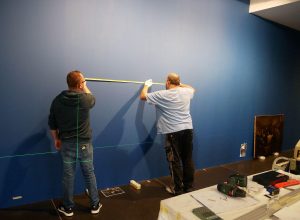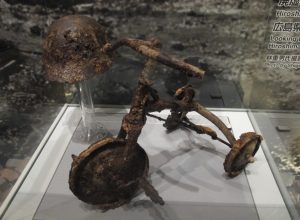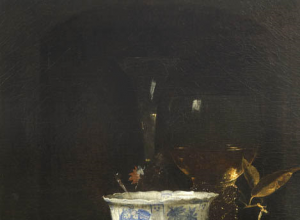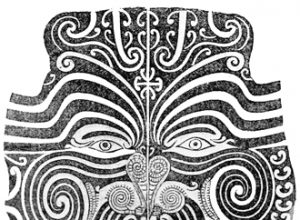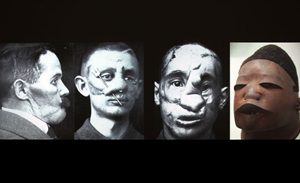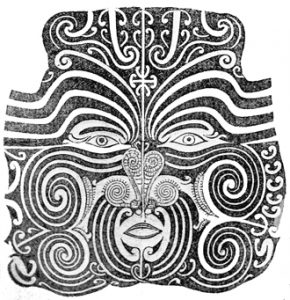
An ethnologist and anthropologist, Mélanie Roustan has investigated the hold objects have over people (her book was published in 2007). She offers us a thorough analysis of things that were sacred for reasons that differ greatly from what, once they have entered museums, defines them for us. The case of eighteenth-century tattooed and mummified Maori heads allows us to grasp how impossible it is to take them as mere objects. Repatriated to New Zealand after a January 2012 ceremony, these heads have finally regained their original function while leaving behind them lasting traces that oblige us to reflect politically on the matter.
Laurence Bertrand Dorléac
Mélanie RoustanAncestors Returned from the Past
The Case of Māori Heads
Can mummified tattooed Māori heads dating from the eighteenth century be considered “things”? How, from museum objects preserved in French national collections, were these toi moko turned (back) into ancestral remains repatriated to New Zealand? Through the tale of this restitution process and of its genesis, we wish to contribute to a reflection on the history of things in a heritage context by unveiling the mechanisms at work in this transformation and by underscoring the ethical and political stakes involved.
A Ritual Duality for an Official Ceremony
On Monday, January 23, 2012, [1] the day of the “ceremony for [France’s] official handover of Māori heads to the New Zealand authorities,” [2] these heads were defined by the strength of the actions of which they were the object and the performativity of the discourses which made of them subjects. On the stage of the Quai Branly Museum’s Claude Lévi-Strauss amphitheater and in the presence of dignitaries from the two countries and from different communities, a twofold ritual was held that celebrated the repatriation agreement between the French and New Zealand nations at the same time that it solemnized the funerals of the restituted remains (Gagné, 2012). Emotions ran high and reverence was the rule. In the audience, a few hundred guests watched Māori women sing and sob, elders pay homage to their ancestors, and governmental ministers make official speeches while also abiding by Māori customs—for example, by rubbing noses to congratulate one another. Seen from the audience, “some of the events remained for me, as well as for a number of French people present that day, enigmatic,” even if we grasped that “the issue was no longer that of altering the status of objects but of honoring the dead—and of supporting, on the international stage, the self-expression of a community and its claims” (Roustan, 2014: 194).
The Quai Branly Museum made itself the megaphone of the autochthonous Māori cause by participating in this national restitution operation and, especially, by offering a framework for carrying out a public homage to ancestors—even though this staging, in the strict sense of a theatricalization, may be read as a spectacular form of detachment. Such ambivalences are to be found again in the reception of the “Māori: Their Treasures Have a Soul” exhibition (Smith, 2011) held prior to the ceremony, which, for the Quai Branly Museum, involved adhering to the curatorial demands of the Māori teams from the Museum of New Zealand Te Papa Tongarewa, including ritual treatments for the objects. The Parisian professionals they encountered were touched by this spiritual dimension and the strong social interactions involved in these practices, yet let some glimpse a gap so great that it left them with a strange sense of oddity and perplexity (Gagné & Roustan, 2014).
Autochthonous Movements (of Objects)
Echoing Western museums’ crisis of authority over their extra-European collections (Marcus & Fischer, 1986; Clifford, 1988; Karp & Lavine, 1991), indigenous, aboriginal, and autochthonous minorities—which, in the popular mind as well as in the scholarly view, have tended to be described as cultures at once unchanged and threatened, as well as to be protected—have for a few decades now been turning around the mandate to treat them as heritage items and making their voices heard on the international stage. These minorities have moved in on the terrain of the museum and on the legal terrain so as to win recognition for their cultural or heritage rights over traditional objects and over human remains of which their forebearers had been dispossessed but also over sites of significance (Battiste & Henderson, 2000; Peers & Brown, 2003; Bell & Napoleon, 2008; Tythacott & Arvanitis, 2014).
Today, certain “decolonized” museums are endeavoring to welcome a plurality of uses for their collections. Through ritual practices, objects have become (again) powerful animated beings and dead bodies living ancestors—at least for some of the involved parties. Following the New Zealand nation as a whole, the Te Papa Tongarewa Museum is developing an explicit and pragmatic policy of biculturality: it is encouraging dual ways of viewing collections and the ritualization of people’s relations to things; [3] it is establishing a shared control of internal decision-making powers between descendants of European colonists and the Māori; and it is recognizing and supporting autochthonous claims upon certain cultural goods, in particular as regards the repatriation of human remains, such as the toi moko (McCarthy, 2007 and 2011).
The Relabeling of Objects as Subjects: In the Name of What?
Yet when in 2012 the toi moko hitherto preserved in French establishments were returned to the Te Papa Tongarewa Museum under the responsibility of Māori teams of this New Zealand national institution, it was not in response to a demand from autochthonous persons or groups but in accordance with a universal principle that this transfer took place. A controversy and then a law were required to effectuate this one-way movement of museum collections. The restitution project set into tension France’s Heritage code [4]—which states that public collections are inalienable—and its “bioethics” law [5]—which establishes that the human body, living or dead, is not a heritage item. In this case as in another one, a few years prior, involving the handover to South Africa of the remains of Saartje Baartman, longtime known as the “Hottentot Venus” (Blanckaert, 2013), the principles behind the adoption of this ad hoc law are based on an extension of the notion of human dignity to persons post mortem.
What is being invoked is the universality of the body’s sacredness and not the cultural particularism of some community or any recognition of its rights. In this way, though benefitting from a strong international mobilization, the concept of autochthony in its today-dominant transnational version (Bellier, 2006) did not become the rule in France. The reasons for this may be historical (the country is not a settlement colony), geopolitical (the postcolonial problem is marked there by the silence enveloping it and by the theme of immigration), and philosophical (the Enlightenment tradition permeates the French Republic, its faith in reason and in the individual, and its values of equality and secularism) (Roustan, 2016).
Physical and Conceptual Displacements
Museums are designed to remove material things from their context—therefore, from the networks of actions and significations within which they are interlinked—in order to preserve them, study them, and transmit them as heritage items. Museums displace these things in fact toward others spheres wherein they are given a new life as to how they are used and represented. The life of objects of/in museums does not stop when they enter into these institutions, which only in appearance have some stability. Processes internal to the sphere of museums whereby heritage items are handed back over testify thereto. Such reappropriations show to what extent action upon material things redraws the political lines between peoples’ memory and nations’ history. They partake of subjectivization processes, which transform and shape individuals and collectives by drawing things and bodies closer together both physically and symbolically. Through this network of actions upon the actions of others, museum institutions reconfigure the balance of forces and the circulation of powers, thereby constituting themselves as devices for the negotiation and redistribution of power over material objects—and of the power stemming from these objects.
In freeing up access to a certain number of objects for commemorative and ritual uses while excluding other ones from networks of exchange, museums negotiate their place within a transnational heritage world situated at the heart of processes of cultural recognition and legitimation. Noting this, we are led to explore zones of friction among the museum’s different political philosophies within a French postcolonial context. Up till what point is to one to welcome communitarian claims? What is one to do about demands for restitution when they are motivated by the sacred character of the objects in question? How is one to reconcile an opening toward the plurality of uses of heritage items with respect for secularism, equality for all with representation for each? The logics of autochthony confront museum institutions with their paradoxical mandates while instilling doubt as to the nature of the things for which they are responsible.
[1] I attended the January 23, 2012 ceremony as part of an international comparative research collective led by Gaëlle Crenn (University of Lorraine), Lee Davidson (Victoria University of Wellington), and Natacha Gagné (Laval University, Quebec City). This research effort bore on the effects, for both staff and visitors, of the traveling exhibition E Tū Ake: Māori Standing Strong designed by the Museum of New Zealand Te Papa Tongarewa. This exhibition was received at the Quai Branly Museum in Paris in 2011-2012 and at the Museum of Civilization, Quebec City, in 2013.
[2] According to the terms on the invitation card.
[3] During a recent visit to Wellington with Natacha Gagné to present the results of our research and to dialogue with the Māori teams of the Te Papa Museum, we were able to note the abundance and diversity (to the point of ordinariness) of ritual or religious practices within this New Zealand institution. Traditional songs and messages, dialogues with ancestors, and calls to purification but also Christian prayers punctuate the daily life of the Museum, from the stockrooms that house the collections to the meeting rooms and passing by way of the exhibition spaces, including with the creation of water supply points for cultural usages. A marae—a traditional Māori space for ceremonies and religious rituals—has been constructed within the museum, which thus welcomes within itself a consecrated site.
[4] More specifically, law no. 2002-5 of January 4, 2002, relative to France’s museums.
[5] Law no. 94-653 of July 29, 1994, relative to respect for the human body; this law was amended in 2004.
Bibliography
BATTISTE, Marie, and James Y. HENDERSON. Protecting Indigenous Knowledge and Heritage: A Global Challenge. Saskatoon: Purich Publishing, 2000.
BELL, Catherine, and Val NAPOLEON. Eds. First Nations Cultural Heritage and Law: Case Studies, Voices, and Perspectives. Vancouver: University of British Columbia Press, 2008.
BELLIER, Irène. “Identité globalisée et droits collectifs: les enjeux des peuples autochtones dans la constellation onusienne.” Autrepart, 38 (2006): 99-118.
BLANCKAERT, Claude. Ed. La Vénus hottentote, entre Barnum et Muséum. Paris: Éditions du MNHN (Archives), 2013.
CLIFFORD, James. The Predicament of Culture: Twentieth Century Ethnography, Literature, and Art. Cambridge, MA: Harvard University Press, 1988.
GAGNÉ, Natacha. “Affirmation et décolonisation: la cérémonie de rapatriement par la France des toi moko à la Nouvelle-Zélande en perspective.” Journal de la Société des Océanistes, 134 (2012): 5-24.
_____, and Mélanie ROUSTAN. “Accompagner les taonga à travers le monde: une exposition māori à Paris et à Québec (note de recherche).” Anthropologie et Sociétés, 38:3 (2014): 79-93.
KARP, Ivan, and Stephen D. LAVINE. Ed. Exhibiting Cultures: The Poetics and Politics of Museum Display. Washington, D.C.: Smithsonian Institution Press, 1991.
MARCUS, George E., and Michael J. FISHER. Anthropology as Cultural Critique: An Experimental Moment in the Human Sciences. Chicago: Chicago University Press, 1986.
McCARTHY, Conal. Exhibiting Māori: A History of Colonial Cultures of Display, Wellington: Te Papa Press, 2007.
_____. Museums and Māori: Heritage Professionals, Indigenous Collections, Current Practice. Wellington: Te Papa Press, 2011.
PEERS, Laura, and Alice K. BROWN. Ed. Museums and Source Communities: A Routledge Reader. London and New York: Routledge, 2003.
ROUSTAN, Mélanie. “De l’adieu aux choses au retour des ancêtres. La remise par la France des têtes māori à la Nouvelle-Zélande.” Socio-anthropologie, 30 (2014): 183-98.
_____. “Des usages de l’autochtonie dans les musées français.” Culture & Musées, 2016.
SMITH, Huhana. Māori–Leurs trésors ont une âme. Paris: Somogy-Musée du quai Branly, 2011.
TYTHACOTT, Louise, and Kostas ARVANITIS. Ed. Museums and Restitution: New Practices, New Approaches. Surrey: Ashgate Publishing, 2014.
Mélanie Roustan is an Assistant Professor at the French National Museum of Natural History, a member of the Local Heritages Mixed Research Unit (UMR208) of the Research Institute for Development (IRD/MNHN), and a teacher within the Museum’s Master’s Program in Museology. An ethnologist and anthropologist, her research, which is centered on material culture (people’s relations to objects), explores the museum’s heritage-based and scholarly dynamics, visitors’ points of view on exhibitions, and the connections between museums and anthropology. She has published Sous l’emprise des objets? Culture matérielle et autonomie (L’Harmattan, 2007); La Place des publics. De l’usage des études et recherches par les musées, with Jacqueline Eidelman (La Documentation française, 2007); Voyage au musée du quai Branly. Une anthropologie de la visite du Plateau des collections, with Octave Debary (La Documentation française, 2012); and “De l’adieu aux choses au retour des ancêtres. La remise par la France des têtes māori à la Nouvelle-Zélande,” Socio-anthropologie, 30 (2014): 183-98. Her present investigations bear on the history of ethnological collections, ethical and political questions relating to museums, and zoological parks.
See the following webpages:
http://www.paloc.fr/index.php/fr/qui-sommes-nous/membres-de-paloc?pid=67&sid=120 and
http://mnhn.academia.edu/MelanieRoustan.
